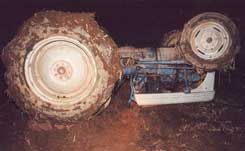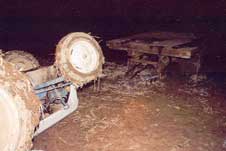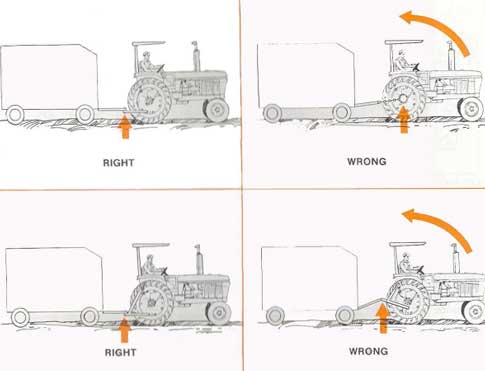Youth Dies in Tractor Rollover Attempting to Pull Trailer Out of Mud
Wisconsin Case Report 03WI033
Summary
On April 21, 2003, a 15 year-old youth died when he was pinned under the tractor he was driving. The deceased had driven the tractor into the field located behind and next to the back yard of his family home to retrieve a trailer to haul wood. The trailer became stuck in the mud. The victim connected a log chain to the trailer and tried to pull it out of the mud with the Ford tractor, Model 8 N. This model has widely-spaced front wheels. Figure 1 shows the tractor after it overturned backwards. Figure 2 shows the front of the tractor facing the trailer. The victim’s friend was driving past the property on the road and saw the tires of the tractor in the air. The friend turned around on the road and drove into the yard. He went to the house to see if his friend (the victim) was there, but no one answered as he called for him. He then ran out to the tractor in the field and found the victim pinned underneath the tractor. He drove to a neighbor’s home to get someone to call for help. He drove back to the victim’s home. In the meantime, the victim’s sister who had heard the friend’s truck but was unable to answer the door at the time, went out and saw the tractor upside down. She ran over and saw the victim under the tractor. She ran back into the house and called emergency medical services (EMS). Within fourteen minutes the emergency medical personnel had arrived from a nearby town and had removed the victim from under the tractor. He was taken to a local hospital where he was pronounced dead.
The NIOSH FACE investigator concluded that, to help prevent similar occurrences, farmers and employers should:
- provide tractors equipped with rollover protective structures (ROPS) and seat belts.
- ensure that youth are trained in and are aware of the potential hazards associated with operating farm machinery through a formal tractor safety-training program intended for youth.
- ensure that the tractor is equipped with an appropriate hitch before using it to pull equipment.
- ensure that youth are informed that they should seek help whenever situations occur for which they lack experience or skill.
- know and comply with Federal and State child labor laws that are related to employment of youth in an agricultural setting.
Additionally:
- know and follow the Association of Equipment Manufacturer’s (AEM) Agricultural Tractor Safety Manual for Operating and Maintenance Personnel “to avoid rear overturns” when attempting to pull a load or move any implement out of the mud.

|

|
|
Figure 1. The tractor after it overturned.
|
Figure 2. The front of the tractor facing the trailer following the rollover.
|
Introduction
On April 21, 2003, a 15 year-old youth died when he was pinned under the tractor he was driving. On April 23, 2003, Wisconsin FACE investigators were informed of this incident via a newspaper clipping. The death certificate, the sheriff’s report and the coroner’s report were reviewed and an investigation was initiated. On March 25, 2005, the FACE director/field investigator traveled to the home of the deceased and talked with the victim’s family. His mother and sister shared information about the victim and the incident.
The family grew up and lived in the area all of their lives. The family owned their home adjacent to their neighbor’s field where the incident occurred. The victim’s father worked loading trucks in a gravel quarry and the victim’s mother worked at home. The deceased was a high school student. The Ford tractor had been in the family for many years. Approximately 5 years before the incident, the tractor was no longer needed on the home farm and was given to the victim’s family. The victim loved the tractor and at age 10 learned very quickly how to drive it. He often drove the tractor in the field behind their home. The field was flat with no trees, hills or slopes and the family could see him easily from their home. The victim learned about machinery and safety from his parents. While he took the hunter safety training course when he was eligible, he did not participate in the tractor safety course. The family used the tractor to haul wood, plow the garden and plow snow. The victim was described as very adept at fixing and creating things, hunting, and fishing. The tractor was described as his pride and joy. The victim and his father both loved machinery and spent time together converting an old truck into a trailer.
Investigation
On the day of the incident, the victim had a vacation day from school and slept until his mother awoke him later than usual. That evening the parents were going to the high school to enroll the victim in driver’s education that would be taught in the summer. Before they left, they asked the victim to haul wood and put it into the basement before dark. They did not know he would use the trailer. They expected him to use the manure spreader from the garage located near the house.
The victim spent time with his friend who left him at approximately 6:00 and 6:30 p.m. He watched television with his sister until approximately 7:20 p.m. The victim then went outside. Since the event was not witnessed, the circumstances leading to the victim being pinned under the tractor are postulated based on the review of the incident and the interviews with the family. The victim drove the tractor to the field to retrieve the flat bed trailer that had been converted from an old truck. The trailer got stuck in the mud. The victim found a logging chain and connected the hitch of the trailer to the back of the tractor with the chain. The victim was attempting to pull the trailer out of the mud with the tractor when the tractor flipped over backwards and pinned him underneath. The tractor flipped backwards with the front end of it upside down facing west. The trailer was about 15 feet further west of the tractor. Figure 2 shows the tractor and the trailer.
About 8:00 p.m. the friend who had left the victim earlier, was driving on the road past the victim’s house and field. He saw the tractor tipped over with the wheels up in the air. The friend turned around and went to the house to see if his friend (the victim) was there, but no one answered when he called out for him. He then ran out to the tractor in the field and found the victim pinned underneath the tractor. He drove to a neighbor’s home and knocked on the window to get help. In the meantime, the victim’s sister who had heard the friend’s truck, but was unable to answer the door at the time, went out and saw the tractor upside down. She ran over and saw the victim under the tractor. She ran back into the house and called emergency medical services (EMS). The friend went back to the victim’s house and stayed with the victim’s sister for a few minutes before leaving to see if the rescuers were coming. Within fourteen minutes EMS responded and removed the victim from under the tractor. EMS personnel transported the victim to a local hospital. The parents were located and were present when the victim was pronounced dead at the hospital at 9:06 p.m.
The tractor had a 3-point hitch. It is unknown if the tractor had water for weight in the tires. The tractor was a Ford and the research indicates this was a model 8N. This model was tested at the University of Nebraska between 1947 and 1950. The tractor tested at that time to have a 20-30 horsepower engine and weighed 2717 pounds. It could pull a maximum of 2810 pounds. This model did not have a ROPS and was manufactured before the time that a tractor could be retrofitted with ROPS.
The flat bed trailer had large dual wheels on each side and a hitch. It also had a jack so it could be raised in order to hook it up to the tractor. In this instance, the trailer was not hitched directly to the tractor. A log chain was used to connect the two pieces of equipment.
The field had a flat terrain and was wet and muddy at the time of the incident. While April 21 was 52 degrees and clear, the Wisconsin State Climatology office shows that between April 16 and the morning of April 21, a total of 4 inches of snow fell in this geographical area. Rescuers sunk about 3 inches into the ground when walking in the area where the incident occurred.
Cause of Death
The cause of death as stated on the death certificate was open skull fracture with severe brain injury.
Recommendations/Discussion
Recommendation #1: Provide tractors equipped with rollover protective structures (ROPS) and seat belts.
Discussion: The tractor involved in this incident was manufactured in the late 1940’s to the early 1950’s before ROPS were required and too early a model to be able to retrofit it with ROPS. These safety features were not required until 1976 when OSHA standard 1928.51 went into effect. Though the standard did not require the retrofitting of all tractors manufactured before 1976, ROPS on tractors would greatly enhance the safety of the operator. The tractor involved in this incident was not equipped with a ROPS. For a ROPS system to be effective, a seat belt must be used at all times. If a seat belt is not worn, the operator could be crushed not only by the tractor, but by the ROPS as well if the tractor overturned.
Recommendation #2: Ensure that youth are trained in and are aware of the potential hazards associated with operating farm machinery through a formal tractor safety training program.
Discussion: All workers who operate farm machinery must be trained to recognize the hazards associated with farm machinery and how to react in dangerous situations. In the state where the incident occurred, youth age 12 and older are eligible to take tractor and farm equipment safety training to ensure their awareness of potential hazards associated with operating farm machinery while operating a tractor. It is important that hazards with regard to the terrain and the condition of the land are recognized and that youth recognize when they must obtain assistance from an adult when situations occur that are beyond their experience and skill level. Youth driving tractors on a public road or hired to work on someone else’s (not their family farm) farm are required by law in this state to take the certification course. The course is also open to youth who drive tractors and work with machinery who are not driving the tractor on public roads or working on a farm, per se.
Note: In this case, the youth was planning on hauling wood. He was not driving the tractor on a public road.
Recommendation #3: Ensure that the tractor is equipped with an appropriate hitch before using it to pull equipment.
Discussion: To prevent upsets, equipment should be towed only from the drawbar or the three-point-hitch drawbar attachment, set at a recommended drawbar height. (Figure 3) The three-point-hitch drawbar attachment should be kept low. If the hitch is raised, it will pull the rear of the tractor down. By hitching the trailer directly to the tractor the force to pull the trailer is reduced. Using a chain instead of hitching the equipment directly to the tractor increases the force to pull the trailer. It is estimated that it takes ¾ of a second for a tractor to tip backwards to the point of no return and a total of 1 ½ seconds for a tractor to fully tip backwards.
In this case, a chain was used. The FACE Investigator was unable to determine the position of the hitch or if a drawbar was used.
 |
|
Figure 3. Prevent Upsets – Tow only from the Drawbar or Three-Point-Hitch Drawbar attachment. Set at Recommended Drawbar Height. (Deere & Co., p. 180)
|
Recommendation #4: Ensure that youth are informed that they should seek help whenever situations occur for which they lack experience or skill.
Discussion: According to the National Children’s Center for Rural and Agricultural Health and Safety, children under age sixteen should not be completing tasks that are rated as a task with “increased hazard and complexity.” Hitching the tractor to move stuck or immovable objects is one of the tasks listed that requires an adult to complete.
Recommendation #5: Know and comply with federal and state child labor laws that are related to employment of youths in an agricultural setting.
Discussion: Employers of youth may be subject to laws of state and federal authorities and must know and meet the provisions of all pertinent requirements. The Fair Labor Standards Act provides standards for employment of youth in certain enterprises. However, the Child Labor Provisions specifically exempt children who work on their family’s farm from the protection of the Act. The state where the incident occurred also exempts family farms from child labor requirements.
Note: In this case, the youth was planning to haul wood.
Additionally:
Recommendation #6: know and follow the Association of Equipment Manufacturer’s (AEM) Agricultural Tractor Safety Manual for Operating and Maintenance Personnel “to avoid rear overturns” when attempting to pull a load or move any implement out of the mud.
Discussion:
- Hitch loads to the drawbar only. Hitching to the rear axle, or any other point above the drawbar, can cause a rear overturn.
- When using a 3-point hitch drawbar, keep the hitch low.
- Use front counterweights to increase tractor stability when towing a heavy load or to counterbalance a heavy rear mounted implement.
- Start forward slowly and gradually increase your speed. Do not rev the engine or pop the clutch. If the tractor is attached to a heavy load, or immovable object, improper hitching may cause overturn.
- If the front end of the tractor starts to lift, reduce your speed and, if necessary, disengage the clutch.
- If your tractor is mired down in mud or frozen to the ground, do not attempt to drive forward. Lift any attached implement and attempt to back out. If this is not possible, tow it out with another vehicle.
- If you get stuck in a ditch, back out, if possible. If you must go forward, move slowly and carefully.
- Travel directly up or down the slope, never across it. When traveling up or down a slope, keep the heavy end of the tractor pointed uphill.
References
- A Guide to Agricultural Rollover Protective Structures. 1997, National Farm Medicine Center, Marshfield, WI. http://www3.marshfieldclinic.org/NFMC//?page=nfmc_rops_guideexternal icon Date accessed: April 2005. (Link updated 4/4/2013)
- Association of Equipment Manufacturer (2003). Agricultural Tractor: Safety Manual for Operating and Maintenance Personnel: To Avoid Rear Overturns. Toll Free 1-866-AEM-0442 or email: aem@aem.org Internet Resource www.aem.org Date accessed: April 2005.
- Deere and Company (1994). Farm and Ranch Safety Management. Moline, IL. Fourth Edition. pp. 153 and 180.
- National Children’s Center for Agricultural Health and Safety. The North American
Guidelines for Children’s Agricultural Tasks. Marshfield, WI. http://www.nagcat.org/nagcat/default.aspxexternal icon (Link updated 8/5/2009). (Assists adults in assigning farm jobs to children 7 to 16 years, living or working on farms.) - National Children’s Center for Rural and Agricultural Health and Safety Tractor
Fundamentals: Driving a Farm Tractor. Marshfield, WI. http://www.nagcat.org/proxy/MCRF-Centers-NFMC-NAGCAT-Guidelines-PDF-T2.1.pdfpdf iconexternal icon. Date accessed: September 2005. (Includes specific guidelines for recommended supervision comparing the complexity of the job, the size of the tractor and the age of the youth for working at that specific job.) (Link updated 11/16/2011) - U.S. Department of Labor (DOL). (1990). Child Labor requirements in agriculture under the Fair Labor Standards Act (Child Labor Bulletin No. 102, WH 1295). Washington, DC: U.S. Government Printing Office. A Fact Sheet pertaining to Federal child labor laws for farm jobs is available at http://www.dol.gov/whd/regs/compliance/childlabor102.pdfpdf iconexternal icon. (Link updated 1/7/2010)
- U.S. Department of Labor (DOL); OSHA. (1978). Definitions of Agricultural Tractor and Rollover. 29CFR 1928.51(a) and (b)(1). Available at
https://www.osha.gov/pls/oshaweb/owadisp.show_document?p_table=DIRECTIVES&p_id=1824external icon Date accessed: April 2005. - Wendel, C.H., Nebraska Tractor Tests since 1920: test #443. 1985. Crestline Publishing Co. 1251 North Jefferson; Sarasota, Fla 33577. P.159.
- Wisconsin Act 455-38.04 (4) and Wisconsin Statute 346.925 contain the requirements for the Wisconsin tractor and machinery operation safety-training course.
- UW Agriculture Extension Wisconsin Tractor and Machinery Certification Program.
http://www.wiscash.uwex.edu/Documents/PDFfiles/TMCmaterials/TMCbrochure.pdf. Date accessed: April 2005. (Link no longer available 4/4/2013)
Wisconsin Fatality Assessment and Control Evaluation (FACE) Program
Staff members of the FACE Project of the Wisconsin Division of Public Health, Bureau of Occupational Health, conduct FACE investigations when a machine-related, youth worker, Hispanic worker, highway work-zone death, farmers with disabilities or cultural and faith-based communities work-related fatality is reported. The goal of these investigations is to prevent fatal work injuries studying: the working environment, the worker, the task the worker was performing, the tools the worker was using, the energy exchange resulting in fatal injury and the role of management in controlling how these factors interact.
To contact Wisconsin State FACE program personnel regarding State-based FACE reports, please use information listed on the Contact Sheet on the NIOSH FACE web site. Please contact In-house FACE program personnel regarding In-house FACE reports and to gain assistance when State-FACE program personnel cannot be reached.
